Wow, you guys. Two days without internet and I have a ridiculous amount to tell you. Better get down to it before I forget everything I wanted to say!
The last time I checked in we were just leaving the Grand Hotel, Cabourg. We headed west to Bayeux, where the star attraction of the whole town is the famous Bayeux Tapestry. For those who don't know, this document in cloth—technically an embroidery rather than a tapestry, the but name has stuck—is almost a thousand years old, having been completed shortly after the Battle of Hastings in 1066. It tells the story of the events leading up to and culminating in the Norman Conquest of England, and was commissioned by someone (the exact patron is unknown) on the Norman side as a piece of propaganda to display to the oft-illiterate English commoners who remained largely unconvinced of the legitimacy of Norman rule. For someone interested in textile history, the thing is fascinating. The actual experience of viewing it, however, was a little odd. It reminded me of going to see the Crown Jewels in England—not least because at least half the people standing in line to see the Bayeux Tapestry were indeed Brits. I guess that makes sense; after all, William the Conqueror did determine the line of their royalty. Another similarity between the display of the Bayeux Tapestry and that of the Crown Jewels, though, is that you're basically herded onto a human conveyor belt and moved swiftly along with a minimum of juicy background information of the type I always hope for. Still, seeing the tapestry was amazing. It's so rare to see a piece of textile art that old, let alone one executed so intricately, with such interesting interplay between different elements.
The embroidery is surprisingly long, sporting nearly forty separate scenes which bleed into each other in interesting ways. Some scenes have "transition" figures—messengers, for example, who are running or pointing from one scene to the next. The entire work is only about a foot high, but it has three registers, with the main action taking place in the large middle section, and the upper and lower registers mostly taken up by embroidery of fables and other animals. The interplay between the main action and the specific things the artist chose to illustrate in the upper and lower panels is fascinating, and apparently the source of much scholarly contention. In scenes of great intensity, like the launching of William's fleet from Normandy or the actual battle itself, the artist has allowed the main action to overflow into the upper or lower register. During the battle, for instance, the lower register acts more or less as the battlefield, setting the stage for the actions of the military leaders by illustrating common soldiers dead on the field, decapitated, mutilated, or being stripped of their armor. It's an interesting use of the three-tiered format, and almost functions like visual perspective. In other places, the artist has created the sense of depth by overlapping ships or horses in contrasting colors.
Understandably, no photography was allowed of the actual tapestry, so I can't show you, but I highly recommend checking it out if you have the opportunity. I became so intrigued by all the things the overly-concise audioguide wasn't telling me, that I bought two books on the tapestry in the gift shop and already started reading one, which is fascinating thus far.
After an abortive attempt to eat lunch at Le Pommier, kindly recommended by Amateur Reader but sadly closed for the post-lunch break, we headed further west to Mont St. Michel. Things started to look very Norman indeed out on this spit of land jutting into the Atlantic, and we passed plenty of cows and sheep grazing in beautiful green fields, as we drove along. We arrived in time to check into our hotel and drive over to the Mont before the sun set but after the parking lot had largely emptied and the bus-loads of tourists departed.
I'm so glad we took this night-and-morning approach to Mont St. Michel, because it's one of the biggest tourist attractions in France—not a good match for my tendency to panic when subjected to large crowds. By eight o'clock, though there were still plenty of people around, it was possible to move at one's ease, to explore the medieval city without jostling elbows at every turn.
Built on a granite rock which for most of the abbey's life has only been accessible at low tide (and then surrounded by quicksand—actually the source of a dramatic episode in the Bayeux Tapestry), the walled fortress-cum-abbey-cum-prison at Mont St. Michel is ideally located for keeping enemies out or prisoners in. The level of density of cobbled stone streets and houses layered on top of one another, means that one is always confronted with new angles and juxtapositions: a twist in a crenelated walkway reveals someone's backyard garden; or one's eye is drawn by the stunning view of the bay, only to light on the blackbirds nesting in the chimneys. Tranquil courtyards catch the last lingering rays of light, and as the crowds thin out it becomes easier to imagine the days when this walled community was inhabited almost entirely by monks, knights, and pilgrims.
We ate dinner on the rock, in one of the many tourist restaurants there, and stayed late enough to see it lit up at the end of the day. Against the massing clouds it looked like the sinister lair looming at the end of some fantasy hero's quest, and I wondered what impression it might have made on a religious pilgrim arriving on a similar evening hundreds of years ago. If anything, the lack of electric lights would have created an even more intimidating silhouette.
After being awakened in the morning by a flock of sheep being herded by our window (in my sleep-befuddled state I thought to myself, "Why are all those tourists pretending to be sheep?"), we braved the morning crowds to visit the abbey itself. This was almost a Disneyland level of claustrophobia, but it was worth it to see the abbey and hear about its long history: as a pre- and post-Benedictine community; as a center of learning and scholarship; as a setting in which to minister to poor pilgrims and schmooze important knights and dignitaries; as a place for the abbots to consolidate their political power and elevate themselves ever-more clearly above the lowly monks; and finally, as a place of imprisonment for several different kinds of criminals.
It was also interesting to hear about the many renovations and restorations at the Mont, and about the thick layers of history that have built up as one generation modifies, destroys, reconstructs, or builds directly on top of the structures from a previous era. The abbey, and probably the whole town of Mont St. Michel, are a many-layered architectural palimpsest, and it's fascinating to think about the ways in which those different layers influence and interact with one another.
One of the most appealing parts of the abbey grounds is the cloister garden, which was reconstructed in the mid-20th century for the return of the Benedictine monks who still live there today. At the top of the abbey, exposed to natural light, the cloisters would have been the central courtyard of the monks' private quarters, giving access to their other spaces, like the refectory and the dormitories. In the heyday of the abbey, the entire top floor of the abbey was occupied solely by the monks, with the middle floor housing knights and important or wealthy guests, and the bottom floor ministering to pilgrims and beggars. This clear hierarchy was interesting to observe in the architecture—it was obvious the degree to which the top floor offered the best quality of living.
From Mont St. Michel we headed to Angers, home of the medieval/early Renaissance Château d'Angers and another famous textile piece: the Apocalypse Tapestries. The château itself is an interesting specimen because it was originally built very early in the scheme of Loire Valley châteaux, and conceived as a serious military fortification. (Later châteaux, built during the Renaissance when no actual military defense was necessary, retain some of the surface traits of this military architecture but not their function.) As you can see from the photo above, the walls are thick, with many intimidating towers pierced by arrow-slots, and the entire fortress was surrounded by a dry moat. Its entrance portal sported a double-portcullis, a drawbridge, and two trap doors: these people were not messing around. As the region became more peaceful and technology changed, the building changed along with it, and King Réné of Anjou made a number of alterations that prettied up the fortress, changing it into something closer to a family home and/or government offices.
My mom asked about gardens in France, and this is the first of several we're planning to see. The château has a surprising number of different kinds of gardens within its grounds: above are the geometrical walkways of the courtyard in the center of the property, which creates a kind of park perfect for strolling in. There are also more casual, English cottage-style flower gardens tucked away in various corners of the fortress, where herbs and a few vegetables are grown in addition to ornamental blooms.
In addition, there is a small rooftop vineyard, although from what I gathered, the royal vineyards during the height of the fortress's power were actually located a few kilometers away.
And lastly, the former moats are now occupied by formal gardens, whose elaborate designs are best viewed from the rampart walk, many meters above.
Although I'm not often drawn to the formal French style of gardening when I see pictures of it, I must admit that these gardens are oddly compelling and beautiful in person. Something about seeing the peaceful, harmonious designs contrasted with the obviously military character of the château has a balancing effect. We learned an interesting tidbit about this particular style of gardening: it was apparently originally inspired by embroidery patterns of the time, with the different textures of plants imitating different embroidery stitches.
Finally, we made our way in to see the Apocalypse Tapestries, which are truly amazing. Non-flash photography is allowed but I didn't have a tripod and the room was very dark, so forgive the above blurry photo: it's just to give you some idea of the scope of this work. Epic in size and subject matter, it fills an entire long, L-shaped room, its upper and lower registers re-telling the Biblical story of the Apocalypse in all the grotesquerie of the 14th century. Seven-headed dragons vomiting floods, the destruction of Babylon by Maurice Sendak-style demons, and trumpeting angels turning rivers to blood and unleashing fires and pestilence, all feature prominently. There are also contemporary political allegories: in one scene, for example, the cavalry of Satan look surprisingly like the English soldiers of the day.
Technically, these tapestries are an astounding feat: they were produced a surprisingly short period of time, with the weavers working at approximately seven times the average speed for a loom weaver these days, and despite their massive scope, there were apparently NO knots on the back prior to restoration in the 20th century. Despite this or perhaps irrespective of it, the actual storytelling of the tapestries seems to modern standards a bit haphazard or lacking a modern sense of "unity," which I find is true of quite a bit of medieval art. (All the cathedrals, for example, whose façades sport mis-matched towers.) The first two groups of tapestries proceed in an orderly way, telling of the breaking of the seven seals and the unleashing of the four horsemen and their attendant catastrophes upon the earth. Starting with the third grouping (of six), the artistic style changes, incorporating geometric background patterns, and the storytelling is more dispersed, with several stories-within-a-story and a few events (like the destruction of Babylon) retold more than once. I'd be fascinated to know more about the history of the Tapestries' production and the symbolism therein, so I was a bit disappointed to realize that we'd lingered over the real thing too long to take a spin through the bookstore. Hopefully I can snag a book on these intriguing pieces when I get home, or later in the France trip. In any case, seeing these in person was quite an experience, and something that couldn't be replaced by looking at photos.
And then, after grabbing some quick panini and stopping off at a boulangerie for pastries to go, we were on the road again to our rural haven at La Grande Maison, a bed and breakfast run by a charming British couple in a 14th-century wine-making estate. Let me just say: SPECIAL PLACE. After getting a bit lost, we arrived while the sun was setting gold and pink over fields of vines and narrow country roads. We were only planning to spend one night here, but by the time Sue and Michaela had welcomed us with glasses of excellent wine and we'd drunk them at the little table in their backyard garden, we had decided to change our plans and stay here an extra night. The delicious breakfast that awaited us this morning convinced us we'd made the right decision, and now we're off to explore some more châteaux...or perhaps just meander through the lovely countryside. I'll let you know what we decide.
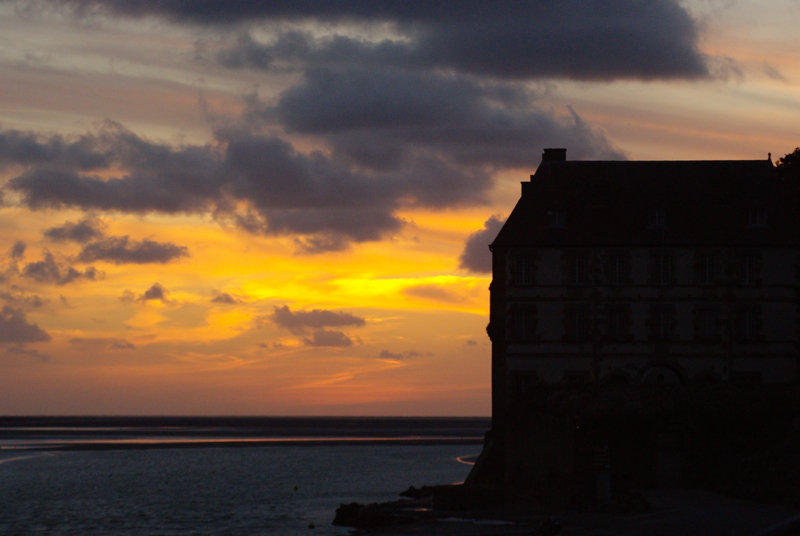
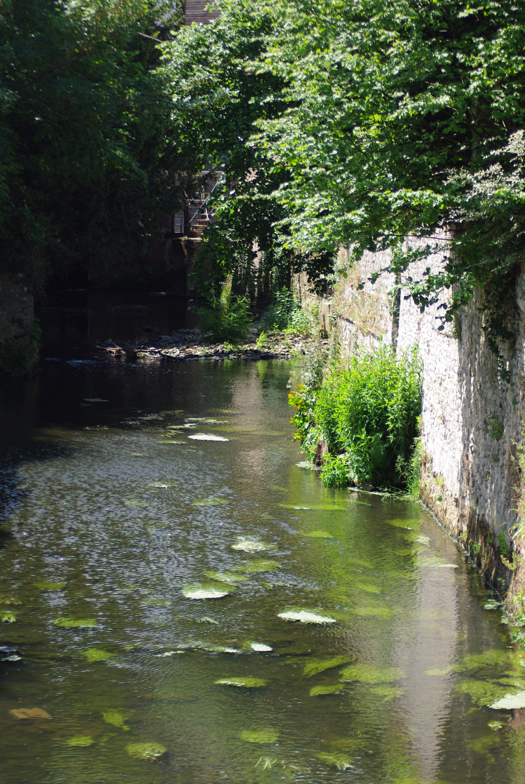
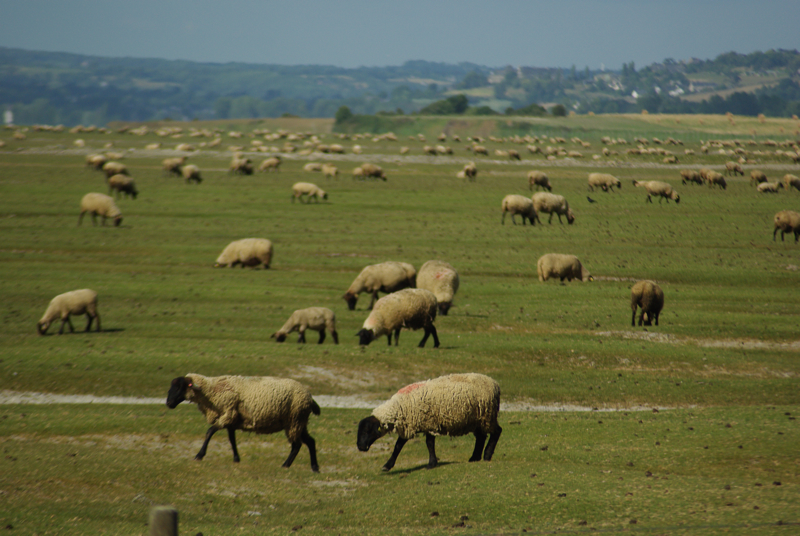
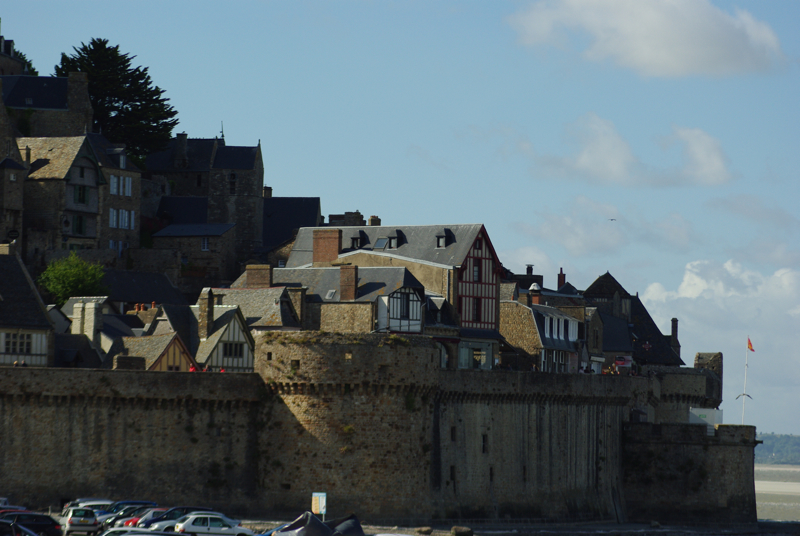
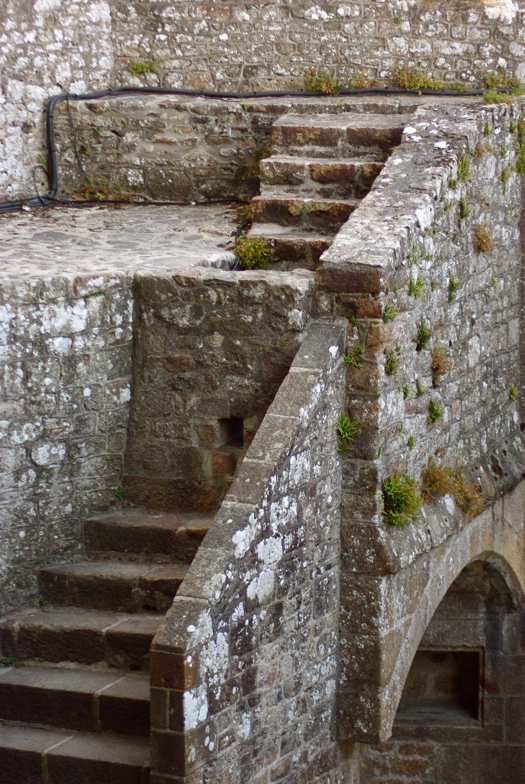
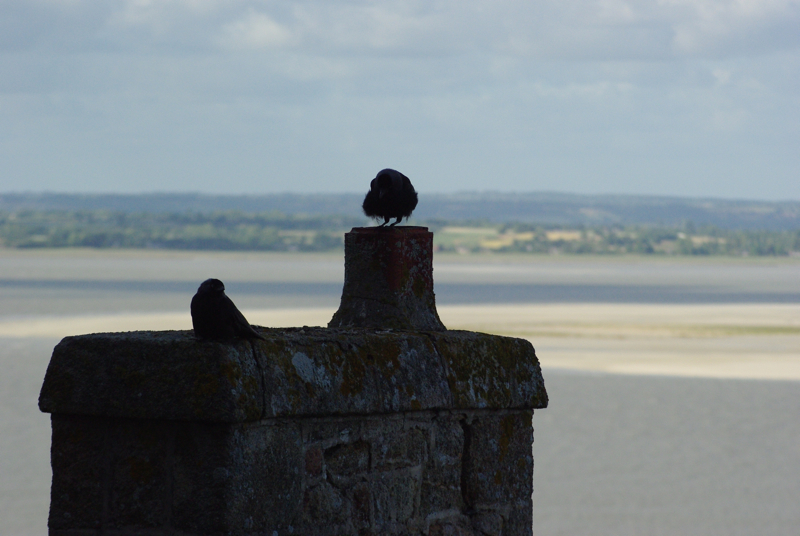
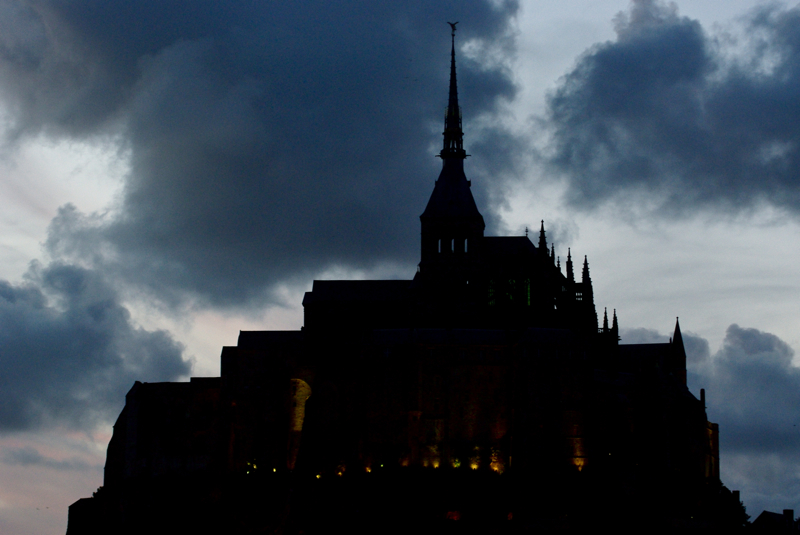
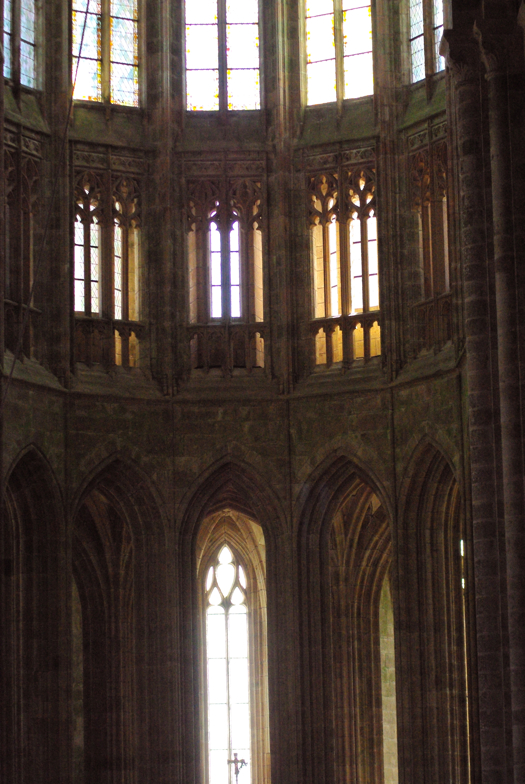
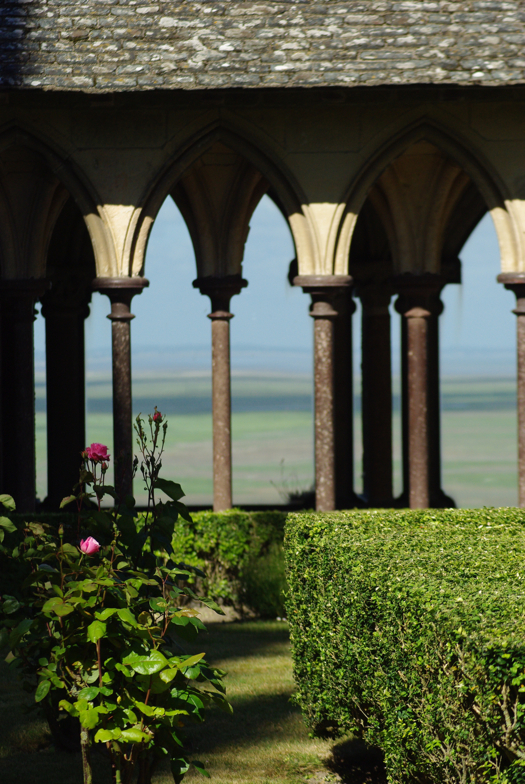
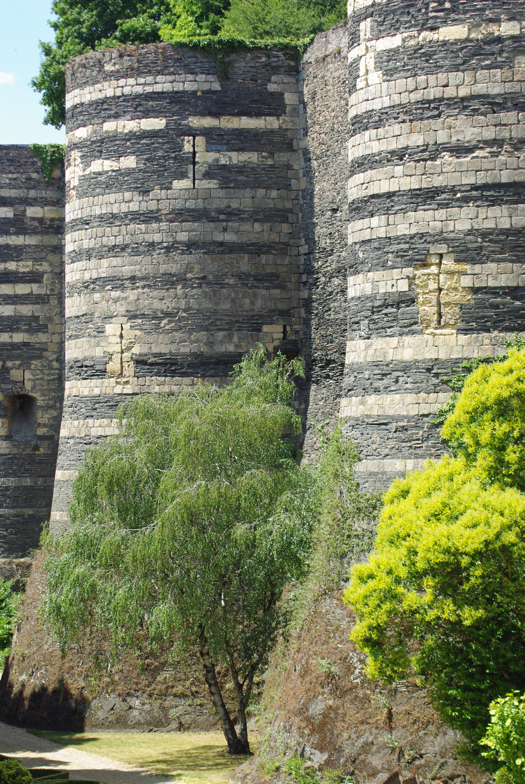
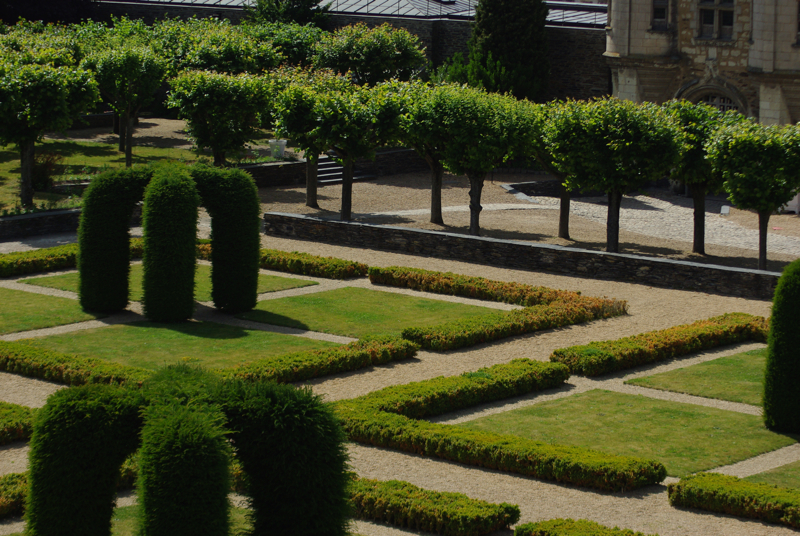
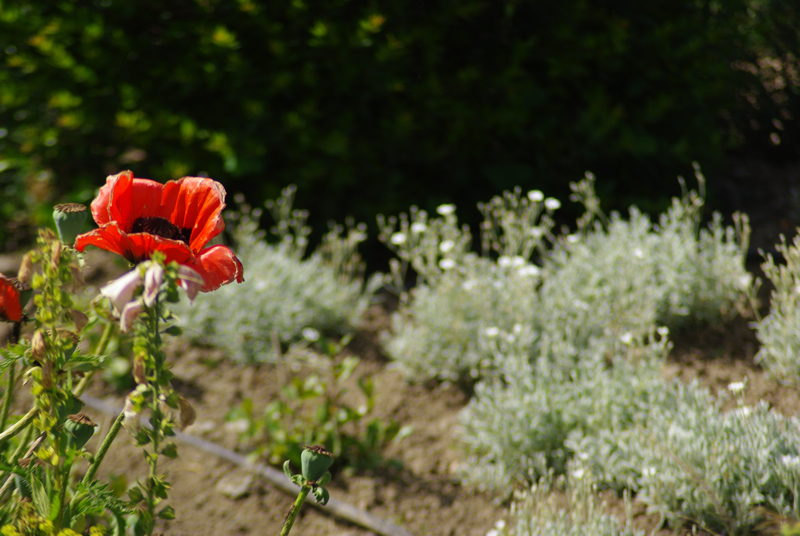
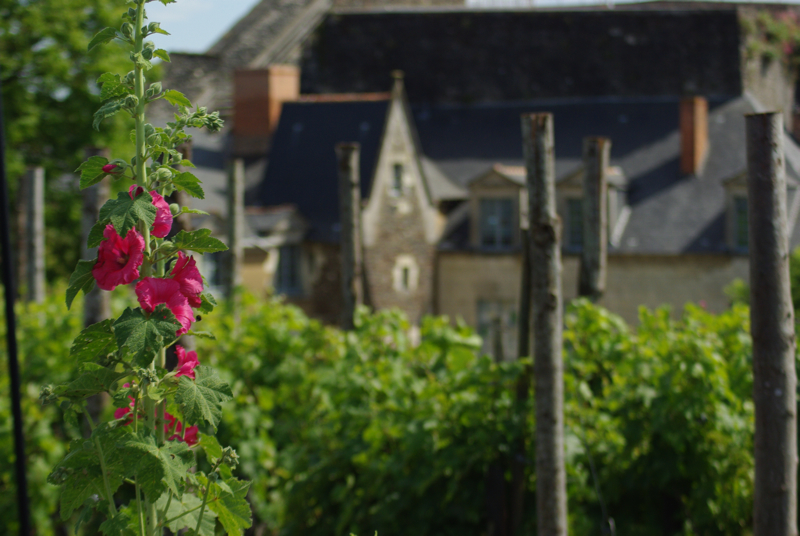
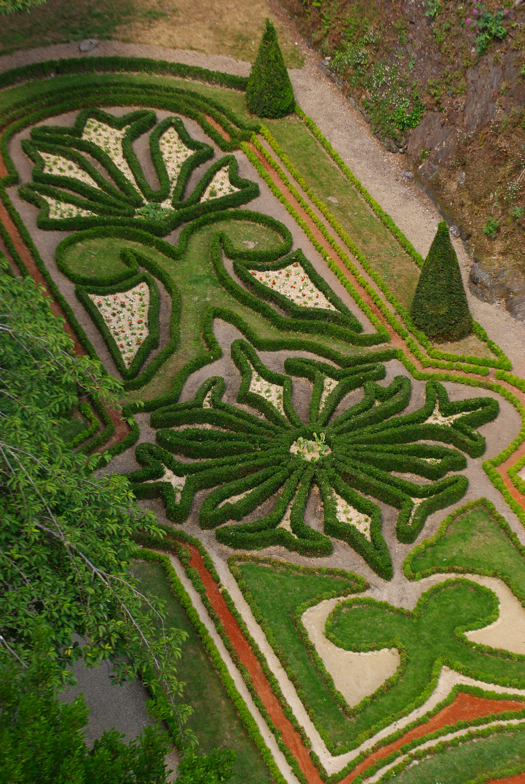
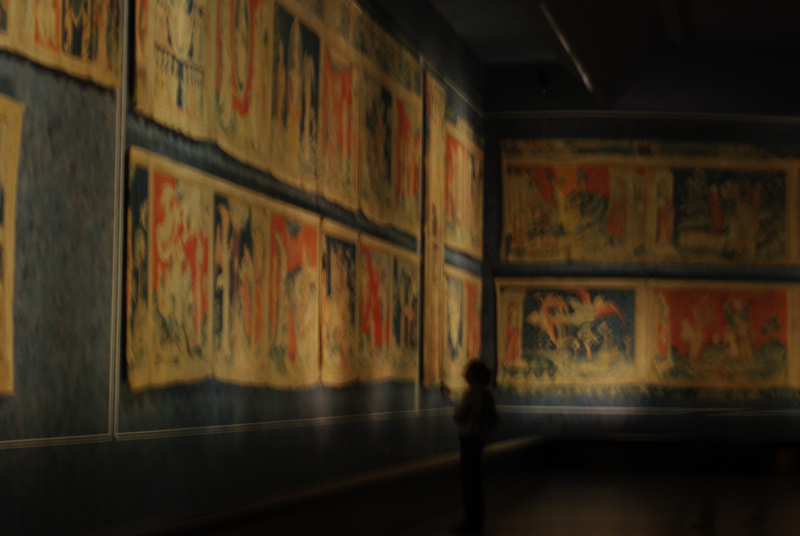
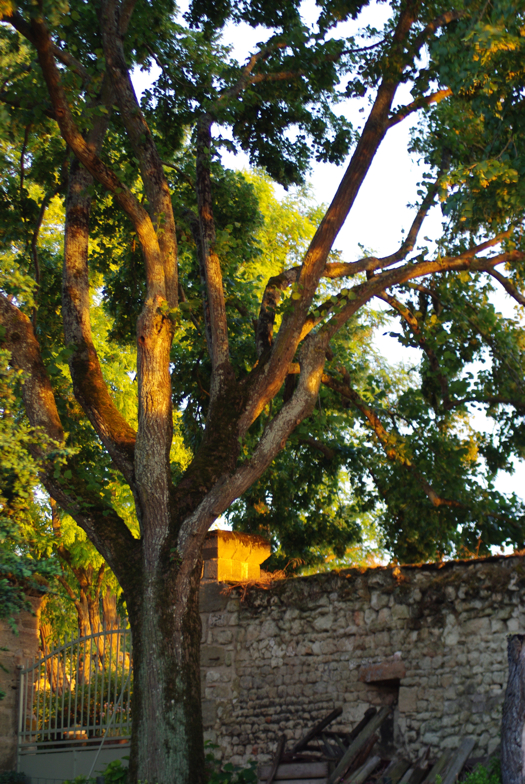
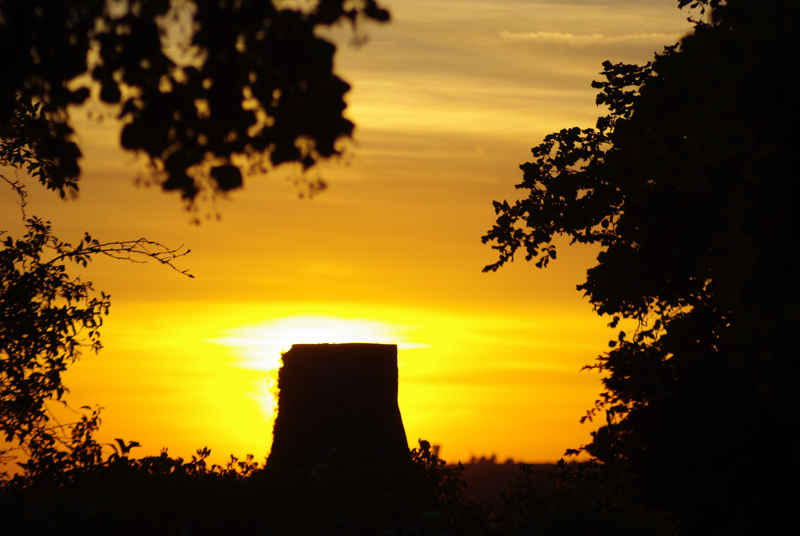


magnifiques photos et commentaires passionnants comme toujours. Figure-toi que je suis allée une dizaine de fois au Mont Saint Michel et que je ne connais même pas le cloître! Les couleurs de la baie sont superbes.
A Lyon un jardin des plantes avait été construit sur la colline de la Croix Rousse exprès pour les canuts (tisseurs des soieries) pour qu'ils y trouvent leurs motifs.
Gardez bien l'adresse de la chambre d'hôte.
A dimanche
Merci! Tes reseignements sur Lyon sont intéressants; il faut que nous revenions en France encore pour voir tout l'est du pays - Lyon, Marseille, Dijon, etc.
Well, large crowds of tourist do tend to behave like sheep so your half awake astonishment isn't that far off. And what an interesting tidbit about the formal garden. I had no idea!
Haha, too true, as we discovered later that day as we tried to make our way cheek-by-jowl with the other sheep. :-)
Mont St. Michel has been on my list of must see places for a long time. I just think it's fascinating. Your trip is drool worthy.
Thanks, Melissa. :-) Mont St. Michel is definitely fascinating. Like most of the places we visited, I found myself craving more detailed information about its history and the details I noticed at the monastery. I'm sure there's so much to learn!
yet more wonderful pictures looks like sopme great sughts you've seen ,all the best stu
Thanks, Stu! We have indeed seen some amazing things. :-)
Oh you have to read Abbes (there's an acute accent on that e) by Pierre Michon. A book containing three stories that echo off one another about the early founding of the monasteries in exactly this part of France.They are wonderful stories, all about the way that superstition and the numinous become translated into religious meaning - but brilliantly done through engaging stories about a priest discovering he has a child, a boar hunt that ends in tragedy, and the creation of relics. I really loved them and now you've actually been in that area in France they might have extra resonance for you.
Ooh, that sounds like it would help to scratch my itch for more insight into life at the abbey and history of how it ran. Thanks for the recommendation, Litlove! You're always causing my TBR to grow. ;-)
I've always wanted to go to the Mont St-Michel, and now with your tantalising account and photograph of the cloister garden it is a MUST. I'd never heard that the formal garden designs were based on embroideries, but it does make sense.
I would highly recommend hitting it first thing in the morning or late in the afternoon, Christine—at those times it is indeed magical. The abbey tour was fascinating and the cloister was certainly a highlight. The spaces are so cool and quiet that they can communicate those qualities even in the midst of the hordes of tourists. :-)